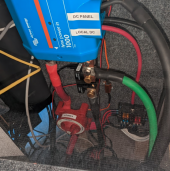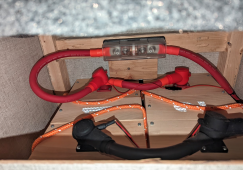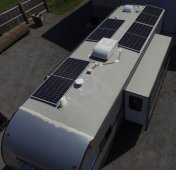Time to share my install. I borrowed the format from jbeletti's post which I found clear and concise. There are more details on my build log.
OVERVIEW
RV Layout and component locations. The only space consumed that was usable before the install is for the batteries at the bottom of the bedroom closet.

Schematic of devices and wiring

The original distribution panel was upgraded to a single 50a main breaker to leverage the power assist in the Multiplus. A change over switch was installed to allow power to flow to and from the inverter or to bypass it. The breakers by the change over switch is a disconnect for DC going to the panel and the fridge.
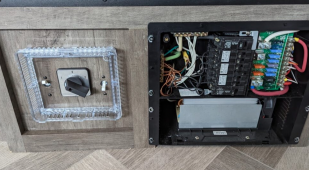
Panels mounted 4x 415w Trina Mono
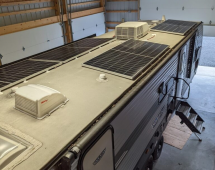
Roof entry (pre lap sealant)

Hacked up the shelf above the fireplace to mount the display panel for the VenusOS display. I also added two 12v outlets for phone chargers.
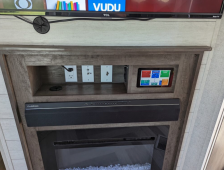
The inverter, solar charge controller, bus bars and wiring are all installed in the dead space behind the fireplace/entertainment center.
Solar panel wiring from the roof with fuses and bus bars.
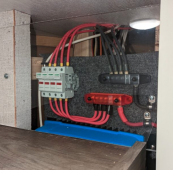
Solar charge controller and breaker/disconnect
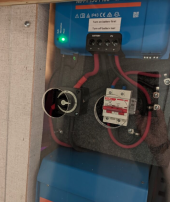
Inverter and primary bus bars
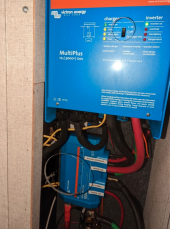
Max photos reached
OVERVIEW
- 1,660w of Solar on Roof (Trina Tallmax - 4 ea @ 415 w) - wired in parallel
- 7,782wh / 608ah@12v of DIY LiFePO4 Batteries (2x DIY 12v batteries with 150a JBD SmartBMS each, 8x total 304ah Eve 3.2 LFP cells)
- 3000va / 2400w Inverter/Charger/Switch (Victron MultiPlus 12/3000-120)
- 100a MPPT Solar Charge Controller (Victron SmartSolar 150/100)
- Battery Monitoring (Victron 500a SmartShunt)
- System Monitoring and Control (Victron Venus OS on RaspberryPi 3B+ with rPi 7" touch screen)
RV Layout and component locations. The only space consumed that was usable before the install is for the batteries at the bottom of the bedroom closet.

Schematic of devices and wiring

The original distribution panel was upgraded to a single 50a main breaker to leverage the power assist in the Multiplus. A change over switch was installed to allow power to flow to and from the inverter or to bypass it. The breakers by the change over switch is a disconnect for DC going to the panel and the fridge.

Panels mounted 4x 415w Trina Mono

Roof entry (pre lap sealant)

Hacked up the shelf above the fireplace to mount the display panel for the VenusOS display. I also added two 12v outlets for phone chargers.

The inverter, solar charge controller, bus bars and wiring are all installed in the dead space behind the fireplace/entertainment center.
Solar panel wiring from the roof with fuses and bus bars.

Solar charge controller and breaker/disconnect

Inverter and primary bus bars

Max photos reached



